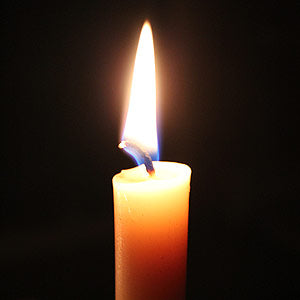 Our customers are amazing! Paul in Toronto is a good example of how amazing. He noticed a little problem that comes up now and again when burning Honey Candles® 6 inch Tubes. He set out to observe when a carbon cap is formed on the wick and figured out why. He sent us off an e-mail and here’s what he had to say,
Our customers are amazing! Paul in Toronto is a good example of how amazing. He noticed a little problem that comes up now and again when burning Honey Candles® 6 inch Tubes. He set out to observe when a carbon cap is formed on the wick and figured out why. He sent us off an e-mail and here’s what he had to say,
“I was just going to write you re the little note you include on burning the candles. The note mentions that a carbon cap sometimes builds up on the top of the wick. I’ve always noticed that as well. After countless years of burning all types of candles of all sizes, I have been puzzled why it happens to some wicks and not to others. A couple of months ago I suddenly figured it out. I have the answer and you can test it for yourself. THE REASON A CANDLE DEVELOPS A CARBON CAP IS BECAUSE THE WICK IS STRAIGHT UP AND DOWN. IF THE WICK CURVES TO THE SIDE AS IT BURNS, IT WON’T GET A CAP. For some reason some wicks don’t bend and some do (that part I haven’t figured out). This happens with both beeswax and paraffin. But take a wick that is burning straight and it will surely develop a cap. Now take that wick while it is burning and take a pair of needle nose tweezers and carefully bend it over and after a little while that cap will burn off, literally vaporize. It seems that a bent wick will naturally burn off cleanly at the edge of the flame while a straight wick is in the middle of the flame and doesn't. I don’t really understand the science. Is the edge of the flame actually hotter? Is there more oxygen there for more complete combustion?”
 We aren’t sure about the science either. We do know the wick is designed to burn properly with a little curl in it. In the first photo you see a candlestick burning as it was intended to, with a little curve in the wick and a nice flame. We have noticed as Paul did that when the wick is straight is when it is most likely to form a carbon cap as the second photo shows. Paul indicated he then curls the wick with needle nose tweezers when that happens and it burns off. I often snuff the flame out at that point, trim the wick and relight.
We aren’t sure about the science either. We do know the wick is designed to burn properly with a little curl in it. In the first photo you see a candlestick burning as it was intended to, with a little curve in the wick and a nice flame. We have noticed as Paul did that when the wick is straight is when it is most likely to form a carbon cap as the second photo shows. Paul indicated he then curls the wick with needle nose tweezers when that happens and it burns off. I often snuff the flame out at that point, trim the wick and relight. If you have any other questions about burning any of your Honey Candles® candlesticks check out this blog:
Honey Candles are hand made in Canada using only cotton wicks and 100% pure Canadian beeswax.










